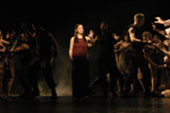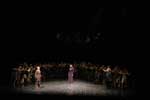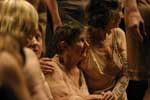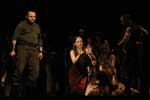Witnessing, Weeping and Outrage — Modern Contexts and Ancient Woes in Euripides' The Trojan Women at the State Theatre Company of South Australia, November 2004.
by Ruth Thompson
On the night of 17 November 2004, at the close of a performance of the State Theatre Company of South Australia's The Trojan Women, just as the audience was beginning to shift from its seats, a woman's voice called loudly from the lower balcony on stage right of the auditorium, 'And this is what's happening in Falugia today.' The woman moved from her seat to the front corner of the lower balcony, from where she gesticulated in the direction of the stage and repeated, 'This is what is happening in Falugia, today. We should be ashamed.' Many of the audience were still seated, but most of those who were standing or walking towards the exits stopped and turned in her direction. From several different points within the auditorium came concurring cries of 'Shame! Shame!' A man's voice from the upper balcony made loudly disparaging remarks about the Australian Federal Government. The woman called out again 'It's our troops, in Iraq, now, killing women and children.' More cries of 'Shame!' And then some of the people standing began to applaud the woman. Other voices joined in from several different places within the auditorium - overlapping - too many to decipher all of them clearly - making comments about our collective responsibility as electors of the current government; as citizens of a country that had sent its troops to an 'illegal war'; that we must not passively allow it to continue...Shouts of, 'Here, here'. More shouts of 'Shame!' More scattered applause. Then it was over, and people continued to make their way out of the auditorium (personal recollection). When I talked to co-writer and director Rosalba Clemente the next day about this response, she said 'Good. Good. I feel now that I've done my job.' (Clemente, personal interview: 18.11.04)
The importance of theatre as ritual and spectacle in the political and socio-religious life of ancient Athens, as well as its connections with the development of Athenian democracy, is commented upon by many scholars. Also commented upon is the remarkable re-emergence of these ancient tragedies upon contemporary stages especially over the past 35 years (see Hall, MacIntosh & Wrigley, 2004). The questions consistently asked of this contemporary phenomenon are, 'Why?' and 'What can our modern society gain from watching new adaptations of ancient texts?' When discussing the reception of adaptations of ancient texts by twentieth- and twenty-first century audiences, I believe it is possible to trace similar connective patterns to those that are said to have existed within ancient Athens, namely the relationships between stylised spectacle, dramatic content and socio-political contexts, and their collective contribution to the exercise of energetic democracy.
In her 1995 Boyer Lecture series, prominent Australian sociologist and social commentator, Eva Cox, discussed her views about how best to maintain and promote 'A Truly Civil Society.' Cox referred to the work of American political scientist Robert Putnam, and agreed with his identification of 'the need for a strong active civil society to make democracy work.' (Cox, 1995: 17) They both also contend that for democracy to work there must be a cultural climate in which strong reciprocal trust networks operate, because reciprocal trust allows people to feel safe to speak out and respect the rights of others to do the same. These networks are said to be most evident in societies rich in social capital. Social capital is categorised by Putnam into two major areas: bonding (exclusive) and bridging (inclusive). One of his briefer explanations of these differing categories is that 'Bonding social capital constitutes a kind of sociological superglue, whereas bridging social capital provides a sociological WD40 [a lubricant]' (Putnam, 2000: 23). While Putnam acknowledges that the more inward-looking bonding social capital can contribute positively to some social networks, he is concerned that with its 'strong in-group loyalty it may also create a strong out-group antagonism' (Putnam, 2000: 23). Therefore, his emphasis is upon the need for bridging social capital which 'requires that we transcend our social and political and professional identities to connect with people unlike ourselves' (Putnam, 2000: 411).
Cox defines social capital as 'the processes between people which establish networks, norms and social trust and facilitate co-ordination and co-operation for mutual benefit.' (Cox, 1995: 15). Cox includes in her definition 'join[ing] a local choir ... arrang[ing] theatre parties or whatever we do with friends and sometimes strangers'. (Cox, 1995: 19) It is with these definitions of social capital in mind that I wish to briefly re-visit Clemente's production of The Trojan Women, the publicity surrounding it, and subsequent interviews with Clemente and co-researcher and writer, Dawn Langman, who also played the part of Hecuba in this production.
Clemente's vision of a production of The Trojan Women had always included music and 'the notion of a sea of women who represented all generations of women, all races, all cultures...' (Clemente, personal interview: 18.1l.04). To this end Clemente imported musicians and composers who were familiar with the making and playing of early musical instruments, listed in the program as: the Cretan Lyra, the Tarhu (bowed strings), Oud, Saz, Rabab, Baglamas, (plucked strings), Tavil, Dhol, Dolki, Kanjira, Zarb and Daayera (percussion) and Gaidanet (wind). The instrumental music was influenced by 'the modal music traditions of the Middle East, Central Asia and Greece' (State Theatre, Program: 7) and was played almost continuously, sometimes accompanied by single voices, sometimes underpinning or working in discord with the women's chorus, whose choral work was 'firmly rooted in Western European music traditions' (State Theatre, Program: 6). The chorus of women numbered sixty and was mainly drawn from community choirs based around Adelaide.
The stage design of this production presented the stark clear lines of a very high rectangle, framing a deep empty stage, separated into three distinct levels. The entire set was charcoal grey, relieved by precise, irregularly-placed, white, linking triangles drawn Escher-like upon the stage floor, giving the impression of an intermittent paved mosaic alternating with uneven terrain. This was the level upon which most of the action of the chorus and major characters took place. The second level consisted of a low hollow platform approximately two feet higher than the stage floor and running across the entire width of the stage, under which the fog machines were set. This platform was mainly the domain of the hard-booted soldiers who wore modern fatigue uniforms and carried long, slim batons. The hollowness of this platform amplified their choreographed marching and baton wielding to ominous proportions. It also served as the extended entrance and exit routes for Menelaus and Helen. The third level was a high upper gallery occupied by the musicians and non-choral singers, a suggestively 'heavenly' dimension in a production otherwise devoid of gods. A taut scrim, created a semi transparent barrier between the lower and upper platforms and the main playing area.
The phrase 'twenty-first century consciousness' is one that is repeatedly used by Clemente and the State Theatre Company in pre-production publicity. It is also a phrase Clemente used in her later interview with me as an umbrella term that covers such modern concepts as peace and conflict studies, feminism, social justice and human rights. As a theatre practitioner who had previously adapted and directed this same play, I was keen to see how Clemente and Langman had incorporated this 'twenty-first century consciousness' into their adaptation of The Trojan Women.
In a pre-production media release, the State Theatre Company included the following statement: 'Trojan Women [...] is an urgent response to the massive destruction of war in the twentieth century and now the twenty-first century. Its gripping message breaks through the barriers of time to reach us with full force once again.' (Oct 2004) In a newspaper article, Clemente is quoted as saying, 'It has to be sad because of what happens to women in war, whether in Troy, or Iraq or Bosnia or Vietnam.' (Williams, 25.08.2004) The State Theatre Company linked the harrowing nature of the play's content and its relevance to current world issues with a traditional Christmas message for peace and hope: 'Christmas takes on a new meaning in 2004. It is a time of accelerated global crisis. It is a time to renew our hope for a better future.' (Adelaide Matters 53) And, 'Beyond all nations, tribes and borders State Theatre Company invites South Australia to come together as a family and send out their hope for peace to a world in need.' (State Theatre, Media Release: Oct 2004) In the excitement and anxiety surrounding Australia's contentious involvement with the war in Iraq, these statements and others both invited and challenged people to come and bear witness. And bear witness they did, as chorus, relatives, friends, survivors, subscribers and inter-state visitors: The Trojan Women enjoyed a near sell-out season from its first preview on 12 November through to its closing performance on 27 November 2004.
The recruitment of a large number of community volunteers to become members of the chorus may account for some of the production's success in mobilising audiences. All the chorus members were involved in months of rehearsals during which they were taught how psychologically and physically to construct a character, and were introduced to some of Clemente's research on twentieth-century war zones. The chorus' costumes, which were simply 1960s-style under-slips dyed to varying shades of old tea, outlined the women's underwear and torsos, which were otherwise totally bare. This emphasised their physical vulnerability to such a degree that it split my concentration and concern between members of the chorus as performers and the members of the chorus as the performed women of ancient Troy. Clemente informed me that this costuming had been an early decision, based on her research which showed that women who were captured often had their clothing taken away to discourage them from escaping. After attending a second performance, at which occurred the audience response described above, I reflected that this emphasis on the physical vulnerability of the performers probably aided in creating a stronger connection between some members of the audience and the women on stage. This community chorus was important, not only from the point of view of fulfilling a particular dramatic purpose, but also in its role as mass mediator with the audiences. With such a large number of bodies and voices, Clemente was able to draw closer to a 'cathartic' rendition of tragedy than any I had previously experienced. During the scene in which Troy burns, when Hecuba and the women attempt to run into the flames, it seemed that the flames were located off-centre within the auditorium. This brought the force of the women's pain fully into the faces of the audience who had to bear close witness to the physicalised vulnerability and loudly vocalised anguish on the part of women known personally by members of that audience. This massive ululation seemed to beat on and, almost unbearably on, leading to a sense of physical and emotional near exhaustion on the part of chorus and audience alike. This does not make for a comfortable night at the theatre, but in this discomfort lies a possible insight into how the mediation between citizens as chorus and audience still can (and perhaps always did) work.
Clemente and Langman described the research and writing process very similarly. In order to apply their particular understanding of a 'twenty-first century consciousness' to this production, they decided to include references and language they considered would be meaningful to a contemporary main-stage audience. To this end, they both read contemporary political social protest poetry from lands in conflict. Clemente specifically took on the task of studying 'all the major war locations of the twentieth century' and 'having a really good look into all the political, social, poetic, mythological kinds of resonances in the whole falling of the towers and September 11th.' In interview, Clemente quoted one of Cassandra's lines from their adaptation: 'The towers of your city fall, bodies hurtle through space, screams of your children.' She explains, 'For me, that's a September 11th image.' (Clemente, 18.11.04) Langman also commented specifically on the character of Cassandra, saying: 'Cassandra's prophecies included our modern world to make her speeches meaningful today.' (Langman, telephone interview: 18.11.04) Within the production itself, Cassandra's speeches included a mixture of ancient and modern references, the performance of which formed an impression of some images being recalled from past visions and some arriving freshly perceived:
I thought to please you, God,
But made you angry instead.
You spat in my mouth,
And made me see horrors of the future.
They spew and gabble:
Chickamauga, Nek, Melos,
Gulag, Passchendale,
Rwanda, Rwanda,
Taliban, Jericho.
I warned you of their secret weapon.
Saw the wooden horse.
Told you Troy would fall ... No-one listened. (Clemente & Langman10)
A strong conviction as to the importance of the scene between Helen, Menelaus and Hecuba, in which Helen argues for her life, was also discussed. Clemente did not want Helen's argument to be 'just about predetermination' but wanted her to be intelligently aware of her position and her role in the larger picture.' (Clemente, 18.11.04) The 'twenty-first century consciousness' carried into the role of Helen included an awareness of her own embodied position as one of the mythologised and gendered spoils of war. The following speech by Helen connected strongly to arguments being widely promulgated throughout the Australian media at the time; those of the 'real' as opposed to the 'constructed' reasons for the war in Iraq. This speech was one of the most controversial in the production and created discomfort for several reviewers, two of whom found the modern references 'jarring' (Lloyd 40 and Byrne18):
No!
Look at me,
You can't blame all this on me.
This is about money, oil and power.
The Greeks hated the Trojans long before I was born.
The Greeks always wanted Trojan land and Trojan women.
The Trojans always wanted Greek oil and Greek women.
That's not my fight.
I'm only the myth men die for.
I'm the women on the porn sites you feed to your soldiers
Before you send them in to kill.
But I am real!
Look at me Menelaus...
I am REAL! (29-30)
Another point of discomfort in this scene was the vengeful hysteria directed at Helen by the chorus. Clemente commented on the chorus in this scene and linked it to the perpetuation of violence beyond the fact of war: 'This is what happens when we do to others what our abusers do to us [...] and women can do it to women just as easily as men do it to women and men do it to men.' (Clemente,18.11.04) These moments of discomfort can act in an almost Brechtian manner in that they set up an intellectual disjunction to the emotional response. If 'I', as an audience member, am called to witness Helen as a manipulated myth with 'real' human concerns, and if 'I' am emotionally moved and intellectually challenged by Helen's appeal, then 'I' can no longer continue an unquestioned allegiance to her accusers, the women of the chorus.
This scene also illustrates how different aspects of social capital may operate in theatre and, by example, the wider community. As suggested above, the women in the chorus, as performers, are participating in a form of bridging social capital — they are engaging in a group dynamic which connects them to people, ideas and contexts not previously experienced by them and are enacting this to an audience who are similarly engaged. However, as the performed women of Troy they are pursuing the more negative aspects of bonding social capital, those of defining themselves by excluding and victimising another.
It is important to acknowledge here that the 'twenty-first century consciousness' operating within the play will also be inherently present within its audience, and will act to dilute the blame traditionally attaching to Helen. In such a case, where an audience response to the dramatic representations on stage is mediated by a chorus full of friends and acquaintances, and those same friends and acquaintances, sisters and cousins, mothers and aunts begin to bay for blood and torture 'in my name' uncomfortable questions can arise about how to mediate this with current secular beliefs about social justice and reconciliation. It is in this disjunction between intellect and emotion, in these very sites of discomfort, that I think this production has its strongest potential to trouble a modern audience and influence the wider public debate.
The Trojan Women of Clemente and Langman was created from their combined literary, socio-political and theatrical research and resulted in a highly stylised theatrical event, the pre-show publicity for which exhorted people to come and bear witness in a time of world crisis. These contexts, together with particular staged and textual elements within the production, encouraged members of the audience to make connections to events they knew were happening in the world around them, and enabled at least one of them to make a direct connection and to challenge the rest of the audience to make it with her.
Reference
Adelaide Confidential, 2004. Glory, tragedy for Gabriello. Adelaide Advertiser, 23 November, 25.
Adelaide Matters, 2004. Rosalba's finale'. Feature article, October, 53.
Byrne, M., 2004. Hell on earth for women of war. Sunday Mail, 21 November, 18.
Cox, E., 1995. A Truly Civil Society — 1995 Boyer Lectures, Sydney: ABC Books.
Clemente, R.; Langman, D., 2004. Trojan Women, unpublished final rehearsal script dated 27 November 2004.
Easterling, P.E., 1996. Weeping, Witnessing, and the Tragic Audience: Response to Segal. in Silk, M.S, 1996. 173-181.
Hall, E.; Macintosh, F.; Wrigley, A., 2004. Dionysus Since 69. Oxford: Oxford University Press.
Lloyd, T., 2004. Classic Greek Grief. Adelaide Advertiser, 18 November, 40.
Putnam, R.D., 1993. Making Democracy Work: Civic Traditions in Modern Italy, USA: Princeton University Press.
Putnam, R.D., 2000. Bowling Alone: The collapse and revival of American community, New York: Simon & Schuster.
Silk, M.S.,1996. ed, Tragedy & The Tragic, Oxford: Clarendon Press.
State Theatre Company of South Australia, Media Release, Adelaide, October 2004.
State Theatre Company of South Australia, Program, Adelaide, November 2004.
Williams, N., 2004. Women tell truth about Troy, Adelaide Advertiser, 25 August, 24.






